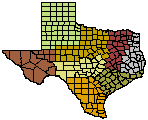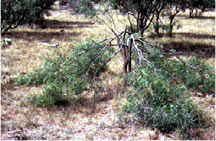- Trans Pecos
- High Plains/Panhandle
- Cross Timbers
- Hill Country
- Post Oak Savannah
- Pineywoods
- Oak Prairie
- South Texas Plains

Wildlife Division District Map
Brush Control and Forest Management
Half-cutting Mesquite
Creating supplemental cover for bobwhite quail will not be
effective unless range management practices are conducted in a way that
provides quail foods. Such range management practices include: prescribed
burning, disking, reseeding tame pastures with native bunch grasses and
forbs and rotational grazing of livestock.
Forest Management
Thinning a forest stand will produce the best results when conducted during the fall and early winter (September – January). Conducting a thinning operation during this time will open the forest canopy, thus allowing more sunlight to reach the forest floor when spring green-up begins. This in turn will stimulate the production of important forbs and browse (young woody vegetation) for white-tailed deer and other wildlife.
When thinning a forest stand to improve wildlife habitat, as a rule of thumb, the forest canopy should be opened up no more than 50 %. Increasing the amount of full sunlight reaching the forest floor from 8% to 45% will generally result increased leaf biomass and improve the palatability of the resulting forage. However, when thinning a forest on hillsides or steep slopes, the canopy should not be opened more that 30 to 40% to prevent, to reduce soil erosion. Habitat conditions are greatly influenced by the amount of sunlight penetration the forest canopy. Therefore, if you are managing for habitat conditions suitable to early succession grassland dependent species, such as bobwhite quail and wild turkey, the forest canopy should be relatively open. Additionally, if you are managing for habitat conditions suitable to mid succession species, such as white-tailed deer, the forest canopy should only open enough to create filtered sunlight. If you are managing to create optimal habitat conditions for multiple species, it is a good idea to provide a mosaic of open, savannah, woodland, and forest if the acreage under management is large enough to do so.
Individual trees selected for removal should only be the ones that are suppressed (trees exhibiting poor growth because of competition) or have low value to wildlife. Such trees include: Eastern red cedar, elms, and any exotic species (species not indigenous to the local region). All mature mast producing trees, such as oaks and hickories, with well established crowns should be protected.
Timing between thinning operations will vary depending on soil conditions, growth habits of the trees, and the habitat condition that you are trying to create. As a general rule of thumb, forest stands should be thinned every 5 to 7 years, or when the canopy begins to shade out 80% or more of the forest floor.
Before carrying out any forest management activities, it is highly recommended to consult with a professional forester. Hiring the services of a consulting forester will help insure that your forest management goals are being met and the timber is being marketed to reputable timber buyers.
Sendero's For Wildlife
A winding network of cleared lanes, know as senderos, through woodlands branching from food plots, and/or natural clearings to the outer perimeters of a tract can serve many purposes which include:
1. providing additional access throughout the property,
2. planting of winter and/or summer food plots,
3. establishment of native pasture seeded with a desirable mix of native
plant species compatible to the soil type,
4. allowing the re-establish into native pasture from the existing seed
source present in the soil,
5. creating fire breaks for annual prescribed burning,
6. hunting and wildlife viewing lanes.
Senderos can provide deer more access throughout the property and encourage the use of the acreage to a higher degree and with more uniformity for foraging, resting, fawning areas, and travel corridors.
Senderos should wind and not be straight paths. This reduces the distance of visibility to suppress poaching from adjacent properties and encourage maximum deer utilization in these areas. Senderos should have a width of at least 75 feet to allow sunlight to reach the soil surface needed to dry and warm the soil and for plant growth.
Senderos are normally cleared with a dozer. Remember, it is
important to have all stumps removed to allow for future soil tilling and
shredding. Be certain that all cleared plant material is piled in the center
of the area cleared and away from the remaining woodland edges. This will
allow for burning these brush piles at a later date. If trees are simply
pushed against the treeline, prescribed burning these wooded areas will
be difficult until this debris is decayed or removed.
For specific information about Leopold's 5 tools as the Apply to the Post Oak Savannah and Blackland Prairie, please click on the appropriate category below.
Brush Control and Forest Management
